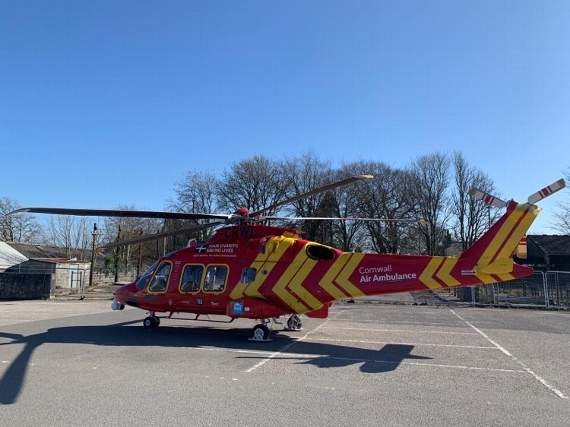THE Cornwall Air Ambulance will be demonstrating its support to the NHS this evening with a fly over at the Royal Cornwall Hospital.As part of a training flight for a new paramedic, the aircraft was set to land on the helipad at Treliske in time to join the 'Clap for the NHS' at 8pm.The Cornwall Air Ambulance and crew have taken a look back at the first month in service of the new helicopter since it first took to the skies at the start of April.
In its first 23 days in operation, Cornwall’s new air ambulance attended 33 critical incidents in Cornwall, Devon and the Isles of Scilly.
The crew also attended nearly 20 more by road using the rapid response vehicles. This number would have been higher had holiday makers travelled to Cornwall over Easter as there is a spike in missions over holiday periods.
Serious illness and injuries are still happening daily despite lockdown and it’s crucial that the skills the critical care paramedics have can be brought to the patient as quickly as possible.Cornwall Air Ambulance continue to attend patients, including those who are suspected Covid-19 cases, bringing their enhanced critical care skills. The Critical Care Paramedics are also part of the wider NHS rota for supporting intensive care transfers around the hospital network to support the sickest ventilated patients during inter-hospital transfer.In addition to its missions in Cornwall and the Isles of Scilly, the Cornwall Air Ambulance also carried out nine flights into Devon during April - as many as during the whole of 2019. These additional operations in support of colleagues across the border were made because the Devon Air Ambulance was grounded for more than a month due to the risk of coronavirus transmission for pilots and crew. The Devon Air Ambulance and its equipment has now been adapted, and were back in the air from yesterday, but the Cornwall Air Ambulance Trust says that the extra missions have cost approximately £50,000.
The benefits of Cornwall's new helicopter include a larger fuel range, meaning that the team can attend back-to-back missions, whereas in the past they would have had to refuel. That saves vital minutes which can ultimately be the difference between life and death.
This advantage was highlighted on the helicopter’s fourth day in operation, where the crew flew to several back-to- back, life-threatening missions without having to return to base and refuel.
Another benefit of the new helicopter is the space inside the aircraft.
Steve Garvey, Air Operations Officer, said: ‘The greater space and access to patients is a benefit of the new aircraft.
‘The scene of an emergency can be a very difficult place to treat a critically ill or injured person.
‘Whether we land at the aftermath of a car accident or find ourselves treating someone on a busy beach, the environment can cause additional stress to a patient. Removing them from the public gaze into a warm, safe environment so we can assess and treat them in a cabin with enough space to do makes a huge difference.
‘The AW169 gives our team 360-degree access to the patient with a stretcher down the middle, whereas in our old aircraft we could only treat them from one side. It may sound simple, but having the extra space to allow two crew members to work on a patient greatly improves the care we can give.’
Fundraising income has declined massively over the past few weeks – a combination of cancelled events and economic difficulty for many people. It costs around £5 million a year to operate the charity and the charity is appealing to the public to continue to support the air ambulance so it can keep flying.
To donate £5 to keep the air ambulance flying and saving lives, text SAVE to 70144.




